| |
|
|
|
|
| |
An International Flashpoint |
|
|
|
| |
|
|
|
|
| |
Abuse of Aboriginal Title & Rights |
|
Wilderness: Awe vs Annihilation |
|
| |
Corrupt Politics: the Downward Spiral |
|
The Struggle of Environmentalism |
|
| |
Corporate Greed: Stump to Dump |
|
A Brave Stand: Betty! |
|
| |
|
|
|
|
| |
|
|
| |
|
|
|
|
| |
The Struggle of Environmentalism
As natural resources dwindle worldwide and competition to exploit them increases along with urban sprawl, environmentalism is routinely crushed by both corporate and government powers. This is especially true in British Columbia (BC), where the economy is dependent on the extraction industries and frontier style developers. In BC there is no tolerance for environmental dissent, as evidenced by the heavy – handed police crackdown at Eagleridge Bluffs in North Vancouver in 2006. Expanding the highway for the 2010 Winter Olympics gave developers lucrative new areas to grab and a unique high elevation wetlands habitat was wantonly destroyed. Citizens protested the ecological carnage (right) and refused to be intiminated by the police, who made over 20 arrests. |
|

Eagleridge Bluffs, 24 May 2006.
Photo: Rob Bowen |
|
| |
|
|
 |
|
| |
 |
|
On 29 May 2009 the Supreme Court of BC issued its "Reasons For Judgement" on the Appeal filed by Betty Krawzyck to protest her jail sentence for Criminal Contempt. Left: Commentary on the judgement by the Eagleridge Bluffs Coalition: Krawzyck vs BC. Betty was lauded for her continued dedication to civil liberties, which are being trampled on in BC by corporations, government, and their shared prerogatives. The judges dismissed Betty's appeal even though they failed to prove 'open, continuous, flagrant criteria.' The conclusion: "So Ends Another Chapter of Justice Canadian Style." |
|
| |
|
|
|
|
| |
mmmmmmmmmmm
mmmm
mmmmmmm
mmmm
mmmmm
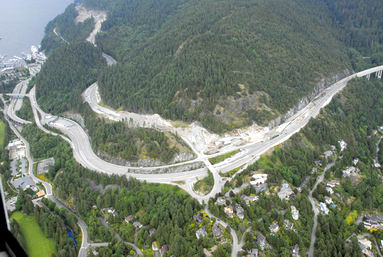
mmmmm.
mmm |
|
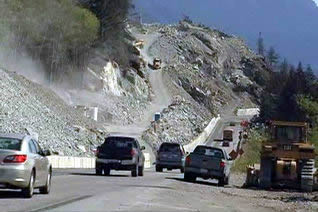
"Premier visits Whistler," 10 July 2007.
BC Government The present BC premier rose to political power through the successes of his development company and his enthusiasm for roads is evident in the many slick PR videos he issueed to promote the Sea to Sky Highway expansion (above). Peter Kiewit Sons Highway of Good Intentions? Vancouver Olympic Plans Bulldoze Rare Forests
Eagleridge Bluffs was sacrificed to enlarge the famously scenic Sea to Sky Highway from Vancouver to Whistler for the 2010 Olympics. The resulting shortcut sliced a five km zone of destruction through two rare ecosystems. Such a flagrant display of habitat destruction makes a mockery of Olympic vows of sustainability. |
|
| |
|
|
|
|
| |
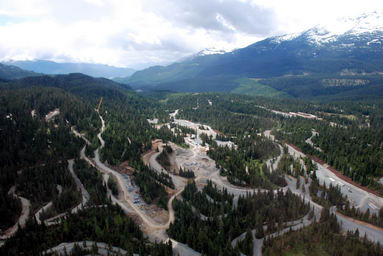
Nordic ski runs, Callaghan Valley, 2007 (Click to enlarge).
Whistler, British Columbia
38 hectares of 250 year old trees were cleared for recreation trails in the Callaghan Valley, adding to the more than 100 kilometres of existing trails. These new recreation trails near the Nordic Centre venue are oversized and permission is being pushed through without public consultation or adequate environmental impact studies despite this being critical grizzly bear habitat. Such urban infrastructure sprawl threatens the survival of the wilderness home of grizzlies. |
|
The centerpiece new Olympic venue at Whistler is the Nordic Centre in the Callaghan Valley where cross country ski runs are now being bulldozed through the forest (left). The hitherto largely undisturbed valley is where the traditional territories of the Squamish and Statimc peoples overlap but the road building and venue construction here is taking place without collective and representative First Nations participation. The collage of four photos below shows: 1) downhill alpine course 2) biathon shooting range 3) bob sled course upper 4) bob sled course lower.
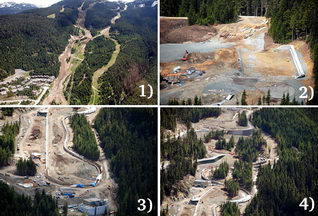
Nordic Centre development, 2007.
Whistler, British Columbia |
|
| |
|
|
|
|
| |
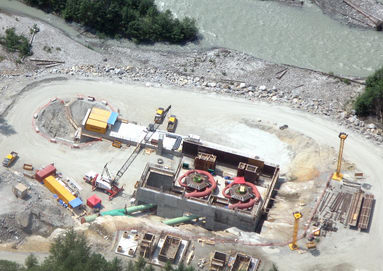
Run of the River.
Photo: Plutonic |
|
Enbridge is a client of National Public Relations – Canadian affiliate of PR giant Burson-Marsteller, an outfit long familiar with the BC environmental movement |
|
| |
|
|
|
|
| |
|
|
|
|
| |
|
|
|
|
| |
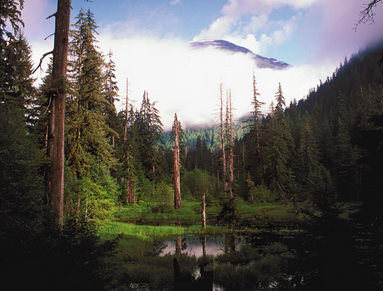
Ecstall River Valley, Great Bear Rainforest.
Photo: Ian McAllister |
|
Pacific Wild Frontline The so called "Rainforest Solution" to make the Great Bear Rainforest on the Northwest Coast a global model of environmental sustainability does not meet the ecological criteria set out by the scientific advisors. Worryingly, no long term protection exists for 85 percent of the timber harvesting land base in the Great Bear Rainforest: Suzuki Stats Report 2005. Are environmentalists Short Selling this priceless repository of biological diversity by giving industry access to so much of it? No agreement should be made that does not provide 100 percent protection for the vanishing big trees and ancient forests. On the contentious issue of collaboration, see Ingmar Lee:
Compromise with a Chainsaw. |
|
| |
|
|
|
|
| |
|
|
|
|
| |
|
|
Grass roots environmentalism is effectively crushed by the use of court ordered civic injunctions called "Strategic Lawsuits Against Public Participation," also known as SLAPPs. On 9 September 2005, a SLAPP was issued to protesters blocking the construction of yet another new logging road the already heavily logged Incomappleux River Valley (above). This is part of the vanishing Inland Rainforest on which the endangered Mountain Caribou depends. |
|
| |
|
|
|
|
| |
Colleen McCrory (1950 – 2007) Resolute forest defender Colleen McCrory was founder of the Valhalla Wilderness Society and an award winning environmental activist. In 2004 she took her campaign to protect BC's Inland Temperate Rainforest to Europe. In Berlin, she met the German Green Minister of the Environment, Jurgen Trittin, to ask for international support for BC environmentalism (right).
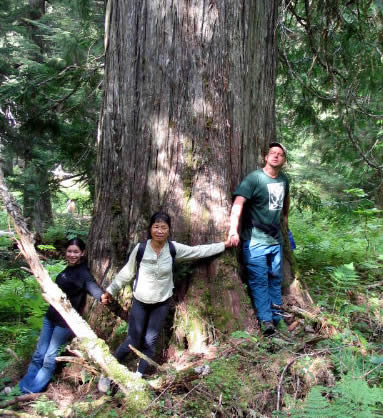
Endangered cedar, Inland Rainforest, 2005.
Photo: Tom Prior |
|

McCrory and Trittin, Berlin, 2004.
Photo: Stephan Roehl One unprotected grove of ancient cedars in the Incomappleux is estimated at 1,800 years old. The enormous value of the rich and irreplaceable biodiversity these trees support has not stopped the profit driven frenzy of the logging industry. To arrest and remove the activists, a court injunction (SLAPP) was initiated by Pope & Talbot, an American company that is buying up pulp and lumber mills across BC while covering up its unethical logging practices with its spurious claim to environmental stewardship.
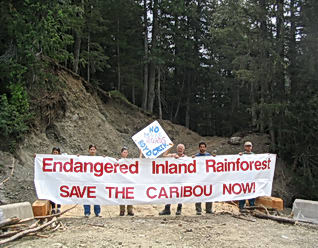
Logging protest, Boyd Creek, 2005.
Photo: Tom Prior |
|
| |
|
|
|
|
| |
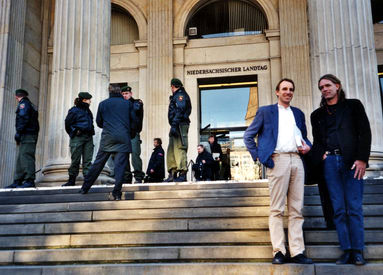
Lee and Wenzel, Hannover, 2003.
Photo: Karen Wonders
Also in Hannover, Germany, at the Legislature of Lower Saxony, Ingmar Lee met Rebecca Harms (right). See: See: Rebecca Harms. She represents the German Green Party at the Parliament of the European Union, but began her successful political career as an activist dedicated to opposing the notorious Gorleben atomic waste site.
The crushing of environmentalism in BC by government agencies and big business has many familiar components in the process which First Nations have been robbed of their land and indigenous rights. These components include the illegal occupation of Indian land, the collusive alliances of the resource industries, the destroying of natural heritage, the repression of political activism, the appropriation of aboriginal culture, and the slick PR campaigning designed to cover up the abuse by lying to the public. |
|
In 2003, Ingmar Lee attended the Legislature of Lower Saxony: Landtagsfraktion Hannover. This was on an invitation by the Green Party leader: Stefan Wenzel. In 2003, the German minister expressed his concern over the problem of old growth deforestation in a letter to Claude Richmond, Speaker of the BC Legislative Assembly. Surprisingly, the German politician did not receive a reply to his thoughtful and well informed letter written in English. Read his letter: Stefan Wenzel.
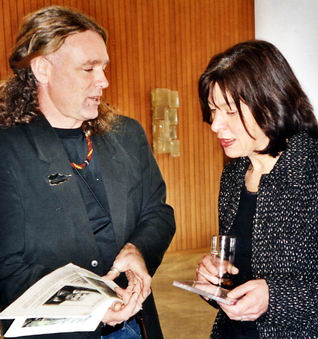
Lee and Harms, Hannover, 2003.
Photo: Karen Wonders |
|
| |
|
|
|
|
| |
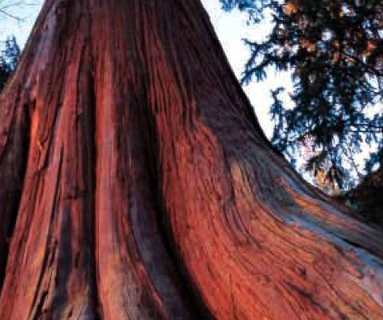
Ancient cedar described as "BC's official tree."
2010 Olympics Committee Bid Book
The western red cedar tree is the "Tree of Life" for many of the indigenous peoples of BC. The extermination of ancient cedars in old growth forests and their replacement by seedlings in tree farms is a disaster for aboriginal culture and Northwest Coast art. The Olympic appropriation of the cedar reveals the unethical practic of cultural theft. Many other instances in BC "are found in the removal of artifacts or human remains from indigenous sites for display in western museums; in the confiscation of traditional plant knowledge and materials for commercial research; and in the adoption, without consent, of indigenous spiritual beliefs or artistic styles, including art work, clothing, stories and songs" Centre for Studies in Religion and Society, University of Victoria: Ethics of Cultural Appropriation
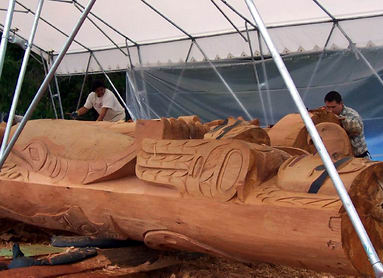
Hesquiaht carver Tim Paul, 2007.
Port Alberni, Vancouver Island, British Columbia
|
|
Vancouver's 2010 Winter Olympics Committee stated in its Environmental Protection Bid Book prepared in 2003: "BC's official tree, the abundant Western Red Cedar has long been a treasured icon of our cultural heritage, our coastal economy and our natural environment" (left). This blatant appropriation in the face of the extermination of big cedars covers up the shameful destruction of both biodiversity and First Nations heritage.
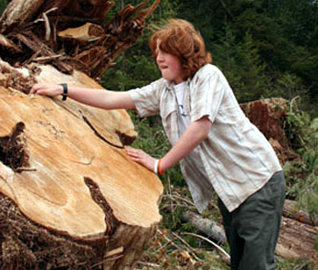
Logged for wood products, 2006.
Photo: Phil Carson
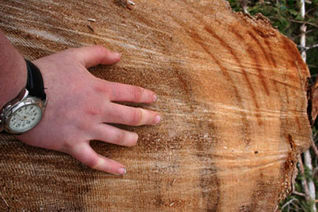
Cedar rings counted: 400 years old.
Photo: Phil Carson
A young boy discovers an old growth clearcut and attempts to count the rings of the cedar tree which he estimates at 400 years old (above). The loss of these trees is a loss of First Nations heritage, including totem poles, canoes and traditional Northwest Coast art. Well known Hesquiaht artist Tim Paul is training three Tseshaht carvers (left). The 25 to 27 foot high totem poles are to be displayed at the Tseshaht owned gas station in Port Alberni. |
|
| |
|
|
|
|
| |
No industrial source of ancient cedar wood anywhere on this planet can any longer be an ethical one. Yet the BC government colludes with big business to exploit the natural resources. If the forests of BC were truly being sustainably managed, as the Ministry of Forestry claims, there would be no industrial logging of old growth trees. Instead the unethical export of raw logs continues along with the marketing of ancient cedar products.
Selling ancient cedar is the equvalent to the illegal trade in endangered species yet the mega franchise Home Depot openly sells ancient cedar wood products with no fear of punishment. See the photo taken at a Home Depot in Victoria in 2007 (right). Stamped on this wood is the logo of the biodiversity wrecker Weyerhaeuser, infamous in BC for its clearcutting of forests with thousand year old trees. |
|
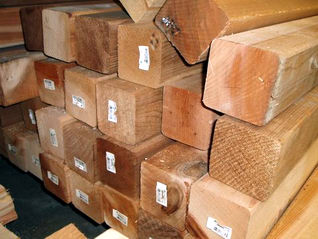
Ancient cedar, Home Depot, 2007.
Photo: Ingmar Lee |
|
| |
|
|
 |
|
| |
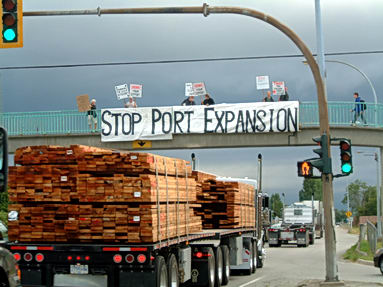
"STOP PORT EXPANSION."
Photo: Gateway Sucks! |
|
Oil sands? Site C? New coal mines? Bioenergy? Privatization of our rivers, the gutting of B. C. hydro, Outright lies on Carbon neutrality, increased emissions, increased forest destruction, false accounting games re C emissions
Another case is the breakneck expansion of Vancouver's Port so that big business can cash in on the export of natural resources to Asia. Environmental protests (left) against the ruination of agricultural land and the increase of marine pollution and traffic congestion have done nothing to stop it. |
|
| |
|
|
|
|
| |
|
|
 |
|
| |

Clearcut logging, East Creek, BC, 2008.
Photo: Richard Boyce |
|
East Creek – 2008 Over 30 per cent of the global forest area is unmanaged primary forest and half of these primary forests are located in the boreal and temperate regions of the Northern Hemisphere. It is increasingly recognized that these forests have accumulated carbon for centuries and contain large amounts of it: Nature (11 September 2008):
Old growth forests as global carbon sinks. Yet today on Vancouver Island, where not long ago some of the most magnificent big tree forests on Earth grew, logging companies with government approval continue to devastate and ruin surviving old growth watersheds (left)
|
|
| |
|
|
|
|
| |

 |
|
 |
|
| |
|
|
 |
|
| |
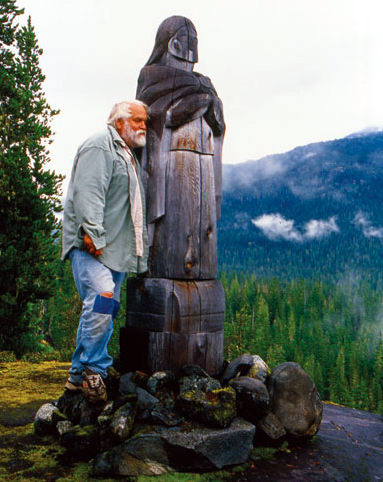
Paul George, Elaho Valley, 1999.
Photo: Wilderness Committee
In 2006 Paul George published an account of his 25 years as an activist: Big Trees Not Big Stumps.Paul George and many other BC environmentalists appear in a 46 minute video by Daniel Gautreau. See: Green Dream$. Produced in 1999, it documents the passionate 1990s environmental battle to protect the wilderness forests that fuel the lucrative multinational forest industry in BC. Many protesters were arrested: "From Clayoquot Sound on Vancouver Island in 1993 to the Stoltman Wilderness just north of Vancouver, in the summer of 1997, passions and tempers raged leading to protests and counterprotests." |
|
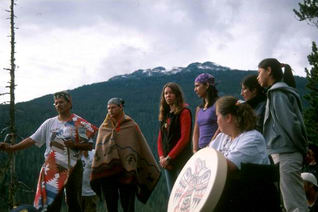
Elaho Valley activists.
Photo: Wilderness Committee
Clearcut logging by International Forest Products (Interfor) in the primaeval Sim Valley near Whistler in Squamish Territory provoked environmental opposition by both First Nations and non natives. A wilderness witness initiative was set up to monitor the devastation:
Uts'am/Witness. The "Cedar Woman" sculpture by Squamish artist Aaron Nelson Moody symbolizes the battle to save the Elaho (left). Standing beside it is the founder of the Western Canada Wilderness Committee, a grassroots environmental group that supports and works with First Nations.
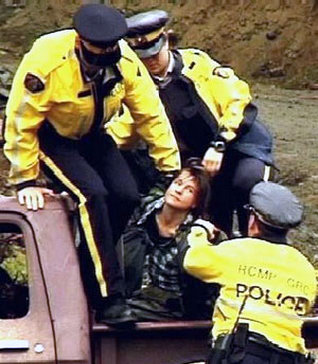
|
|
| |
|
|
|
|
| |

Ancient uprotected cedar, Walbran, BC
Photo: Stan Marée
The ancient forests and their big tree inhabitants remain unprotected from the global wood products industry. On the Northwest Coast of North America, in California, Oregon and Washington, there remains less than 5 percent of the primaeval rainforests that existed prior to the mid 19th century when massive European settlement began. The extermination of ancient forests and trees in BC and Alaska is a double tragedy of biodiversity loss and an immense cultural loss to the Indigenous Peoples. The shocking fact that no laws exist to make the killing of the irreplaceable big trees illegal is due to the inordinate economic power of the logging industry. |
|
When European tourists visit BC, they are astounded to discover that rare and endangered big trees are not protected from the logging industry. Stan Marée, a scientist at Utrecht University, hiked into the unprotected ancient forest the Upper Walbran Valley on Vancouver Island with other Dutch tourists and had his photo taken in front of a red cedar tree that is about 1,000 years old (left). His comment about the threatened status of the forest: "An incredibly beautiful primary forest, can you imagine that a bunch of lunatics want to cut it down to the ground?" (Een onvoorstelbaar mooi oerwoud. Kun je je voorstellen dat een stel idioten van plan zijn om dit hele woud met de grond gelijk te maken?)

Industrial logging, Walbran, BC, 2006
Photo: Wilderness Committee |
|
| |
|
|
|
|
| |
|
|
|
|
| |
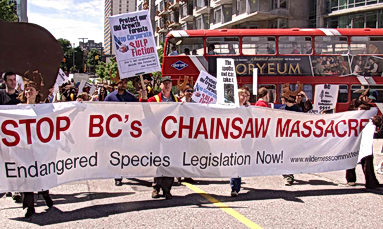
Protest, Vancouver, BC, 2 June 2005.
Photo: J. P. LeFrank |
|
The 2005 Global Forest and Paper Summit in Vancouver was attended by industrial forestry executives from around the world who congratulated BC's forest industry for its record breaking earnings of $1.5 billion. But the high pitched greenwashing of the corporate event could not disguise the ugly truth that the bottom line of the forest industry is to increase production and sell more pulp, paper and wood at the cost of the priceless natural legacy of BC's big tree icons. Western Canada Wilderness Committee members protested at the Summit (right): "As the forest industry talks about 'vision' to enhance its public relations activities, more endangered species habitat is being destroyed." |
|
| |
|
|
|
|
| |
Environmental laws are being dismantled in both Canada and the United States as beloved public forests and national parks are increasingly being made available for commercial exploitation. In BC, this privatization and commercialization of parks has been challenged by the Valhalla Wilderness Society which organized a petition signed by over 60 Canadian and American environmental groups demanding that governments define the criteria to protect parks as enduring public legacies for future generations. The environmental movement has become the focus of much corporate greenwash and public relations propaganda. A typical Rogues Gallery includes those who have been less than honest about their commercial interest in the ancient forests of BC (right). They continue the immoral liquidation of the wealth and wellbeing of future generations while talking the right green language. Behind the guise of sustainability, collaborative partnerships between corporations and governments promote forest policies that in fact destroy precious biodiversity. The forest industry protects its own unethical interests, an example being the world's largest forest products company – Sweden's Assi Doman – which finances positions on the Forest Stewardship Council. |
|
 |
|
| |
|
|
|
|
| |
BC's Inland Rainforest includes groves of ancient trees that have escaped disturbance for many hundreds of years, resulting in rare and endangered habitats with rich and unique ecological characteristics. Big tree groves are located in forests which as a whole may be significantly greater in age than the oldest tree and can be described as antique forests. "Antique forest stands occur in discrete pockets where slope position, aspect and moisture regime protect the forest from disturbance. In addition to hosting incredible biological diversity, the Inland Rainforest is also one of the most productive forest ecosystems in British Columbia and is therefore subject to forest harvesting at an ever increasing rate" Fraser Headwaters Alliance.
The last of the magnificent and unique trees in the Inland Rainforest are being rapidly lost. The photo to the right of an ancient double cedar growing on public (Crown) land is part of an approved cutblock – "Block 486" – licensed to TRC Cedar Ltd. This company is the largest producer of western red cedar posts and rails in North America. See its company profile on Don't Buy SFI. Ancient red cedars are vanishing from the world due to the commercial greed of such unscrupulous logging companies. Demand legislation to stop the global trade in old growth forest products. |
|
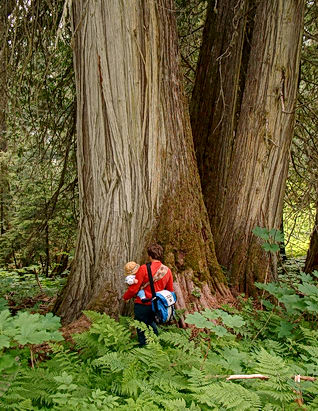
Ancient cedars in an approved cutblock.
Photo: Roy Howard |
|
| |
|
|
|
|
| |
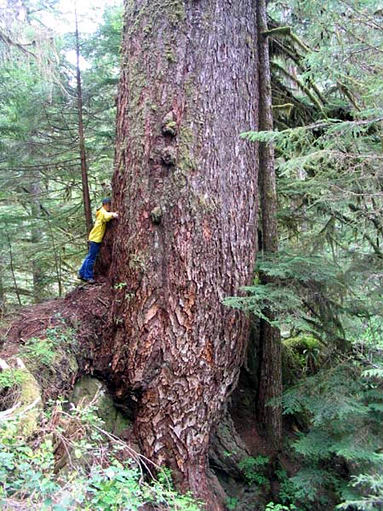
"Big Betty," endangered big tree, 2007.
Photo: Wilderness Committee
|
|
The Upper Walbran Valley is public land that has been seized by a chain of logging companies. These change names regularly to cover up their shameful destruction of the last surviving big trees on Vancouver Island. Ken Wu (above) of the Western Canada Wilderness Committee in Victoria spearheaded a protection campaign in 2006. Walbran protesters assaulted by Hayes and TimberWest in 1998. Ruining public resources like ancient big trees that are the basis of the nature tourism industry is absurd, yet the government continues its pro logging policy of exterminating old growth forests and converting them into industrial tree farms.
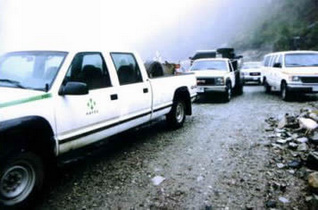
H06.
Photo:
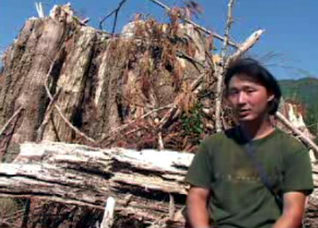
|
|
| |
|
|
|
|
| |
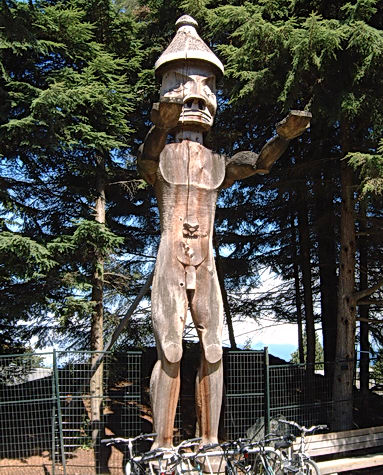
mmmmmmmm
mmmmmmmmmmm |
|
m
mm
mmmm
mmmmmmmmmm 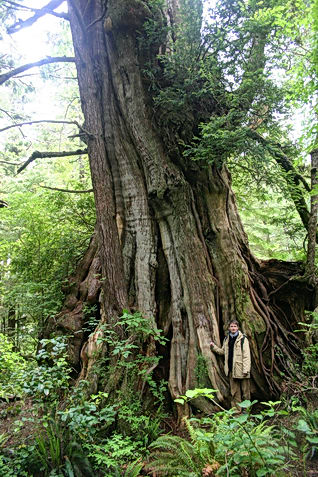
Ancient cedar, Meares Island.
Clayoquot Sound |
|
| |
|
|
|
|
| |
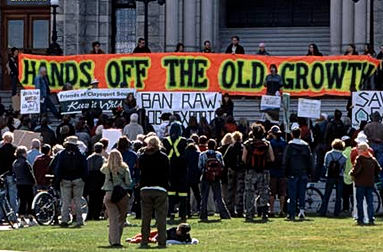
Hands Off The Old Growth, 25 March 2006.
Photo: T. Watt |
|
Western Canada Wilderness Committee launched its Vancouver Island Conservation Vision with a rally (left) 25 March 2006 at the BC Legislature: "Hands Off The Old Growth."On Vancouver Island, a mere 6 percent of the rich valley bottom forest lands are protected in parks and less than 1 percent of the Island's primaeval Coastal Douglas fir zone remains.
This unacceptable situation is largely due to the fact that one fifth of the Island is in the hands of powerful timber corporations. Nothing changes in the BC forest industry except for the company names. Since Teal Jones took over TimberWest's logging rights to the Upper Walbran in May 2005, it has continued to clearcut the endangered old growth forest. See the Wilderness Committee photo gallery: Ancient Cedars. |
|
| |
|
|
|
|
| |
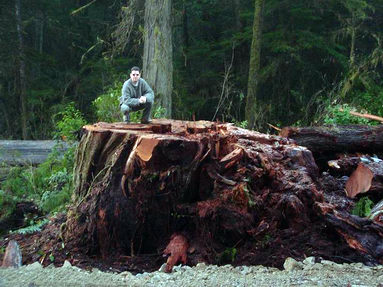
mmmmmm
mmm
mmmmmm 
Clearcut forests and Pachena Grove (X)
Google Earth 2009 (Click to enlarge) |
|
The West Coast Trail is one of the world's most revered wilderness treks and a hike must be booked years in advance. Yet behind the inadequately protected oceanside strip of Pacific Rim National Park Reserve, the primaeval forest is being mercilously clearcut logged – a shocking fact easily seen on Google Earth (left). No amount of government – industry greenwash can conceal the commercial greed that is destroying the last old growth remnants here. Until a land swap was engineered by MacMillan Bloedel, Pachena Grove had been protected within Park boundaries.
|
|
| |
|
|
|
|
| |
Signs at Pachena Point Lighthouse.
West Coast Trail |
|

West Coast Trailhead.
Anacla – Pachena Bay |
|
| |
|
|
 |
|
| |

Southern Vancouver Island.
Map: Click to enlarge
The killing of 1000 year old spruce trees for their commercial lucre as wood products is an ecological crime. Primaeval spruce stands such as Pachena Grove are uniquely found at the sites of ancient indigenous coastal villages, and on Vancouver Island most of these have already been ravaged. Pachena Grove deserved heritage status yet it was openly destroyed in 2006. The Pachena lighthouse, in contrast, is a mere 100 years old and has heritage status. In 2008 its image was chosen for a postage stamp (right). More media attention was given to the mistaken flipping of this image than to the deliberate ruination of Pachena Grove. Both the value of this rare stand of ancient trees as nature heritage and its vital function as a carbon repository are unestimable. Unlike the Pachena lighthouse, which could be easily rebuilt, old growth forest biodiversity as found in the Pachena Grove can never be restored or recreated once it is gone. |
|
Less than six percent of the ancient forests of Vancouver Island are protected and some of the most valuable timber in the Pacific Rim National Park (left) has already been logged. Tourists travelling to the West Coast Trail from Port Alberni see nothing but cutblocks. Pachena Grove was the only old growth stand remaining on Bamfield Road and its senseless destruction will have a longterm detrimental impact on tourism in the area.

Pachena Lighthouse postage stamp, 2008.
Photo: Government of Canada |
|
| |
|
|
 |
|
| |
3 June 2006
"I could not believe the so called selective logging they did behind the West Coast Trail. I drove back there in the fall: there are no forests left between the Klanawa and the Darling Rivers. Black Lake and Michigan Lake were pounded as well. You must have noticed the Pachena cutblock buffer: what a mess. The elected chief says 'no more logging of private land' yet he is logging every speck of that private land. The violations committed in the forests are mind boggling"
West Coast Trail Worries (11 June 2006)
"Weyerhaeuser promised the town of Bamfield a buffer zone would be left between the Pachena cutblock and the Bamfield Road. This was so that tourists would not see the devastation of the last unprotected spruce grove on southern Vancouver Island. Weyerhaeuser took part of the Community Forest yet the town was not even notified about the clearcutting: that's against the BC treaty process. Before when tourists came to this town we were proud to have the last intact old growth forest on the Bamfield Road. Pachena Grove was a magical site, like Cathedral Grove. Now its just another clearcut"
West Coast Trail Worries. |
Tourists hiking the West Coast Trail pass abandoned relics of the logging industry such as the rusting "Empire" donkey engine (right) used to destroy countless big trees in its day. Not far inland from the Trail, forest liquidation continues today. The massive cutblocks seen on Google Earth degrade the protected forest fringe along the ocean by leaving the surviving big trees vunerable to storms and blowdown. |
|

"Empire" donkey engine, 2007.
Photo: Flickr |
|
| |
|
|
 |
|
| |

Big tree on West Coast Trail, 2006.
Vancouver Island, British Columbia
Along with the scientists who want to preserve biodiversity and the tourists (above) who want to experience the big trees of the West Coast Trail, are the communities of Anacla and Bamfield who know that ecotourism is one of the few economic opportunities that remain viable after the demise of the once lucrative fishing and forest industries. It seems ironic that students from around the world travel to the Bamfield Marine Sciences Centre to conduct field research on rainforest and fisheries biology. Yet at the same time the ancient trees that are the keystones of this ecology are
being ruthlessly exterminated. In Bamfield itself, only one giant tree, often photographed, remains (right).
Due to the commercial value of ancient trees, they are not only clearcut logged using huge grapple yarders, but also targeted in remote areas by helicopter logging operations. Corporations spend big bucks on PR to cover up their eco crimes and vaunted certification schemes are surreptitiously put into practice, while the public is stuck with the long term burden of restoring ravaged community watersheds. |
|
The immeasurable value of big trees as reservoirs of intact biodiversity is ever more critical as ecologists report that climate change is contributing to an increased mortality rate of the giant inhabitants of old growth forests (January 2009, Science Magazine). They fear a sudden and widespread "dieback" may result that will devastate the already endangered native forests of the Northwest Coast, leaving fewer living trees to absorb carbon dioxide from the atmosphere.

Ancient cedar tree, Bamfield, 2008.
Vancouver Island, British Columbia |
|
| |
|
|
 |
|
| |
 |
Left: Click image to read the
West Coast Trail Worries
The communities of Bamfield and Anacla lost an important part of their natural heritage with the clearcutting of the stand of ancient spruce trees at Pachena Grove, originally part of the 1977 Pacific Rim National Park Reserve.
Weyerhaeuser employee Stan Coleman is accused of lying when he promised that no damage would be done to the fisheries or to the unique history of the area. |
Macmillan Bloedel and its successor Weyerhaeuser maneuvered the destruction of Pachena Grove using the slick forest industry lobbyist Linda Coady. The unethical and devisive manipulation of impoverished indigenous communities and the wrecking of rare natural monuments and aboriginal heritage are the hallmarks of resource exploitation in BC. Assisted by irresponsible government agents and their underhanded deals, logging companies use frequent takeovers and name changes to avoid public condemnation. Weyerhaeuser, for example, sold out in 2004 to Brascan which was then flipped to Brookfield, a Bahamas registered corporation with no ties to BC communities. |
|

West Coast Trail, Pachena Bay, July 2008.
Photo: Tracy and Joe |
|
| |
|
|
|
|
| |

Logging truck on Bamfield Road, 2008.
West Coast, Vancouver Island, BC
|
|
Another act perpetrated by industry and government was the sabotage of the Bamfield Huu ay aht Community Forest. See the online discussion:
West Coast Trail Worries.
Charged for his criminal mafia deals, Jack Purdy's victimizing of Bamfield has been a well publicized scandal. See:
Baffled in Bamfield (Vancouver
Sun, 6 September 2002). Ever since Huu ay aht lands were invaded by colonists in 1860, the indigenous people have
suffered from the racist policies of imperial culture. Stolen forest resources and timber export were at the
heart of the founding of Bamfield and BC's first sawmill on the Alberni Canal. See David Rossiter:
Lessons in Possession. It is unacceptable that today colonial style abuse continues disguised as celebratory rhetoric in treaty negotiations. |
|
| |
|
|
 |
|
| |
|
|
| |
©
Credits & Contact |
|
| |
|
|
|
|

